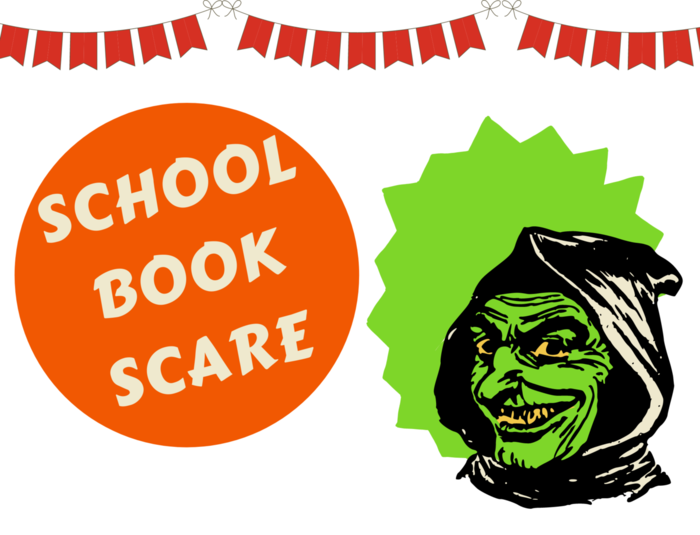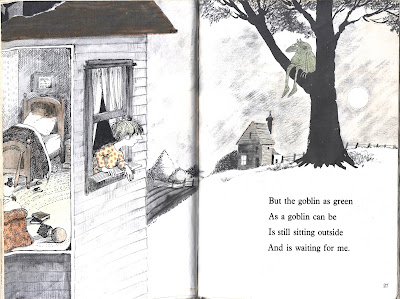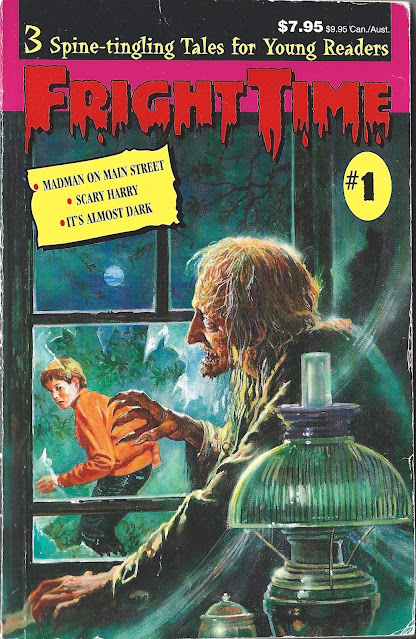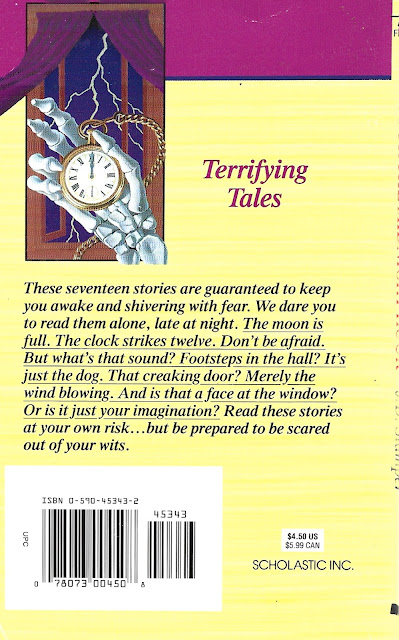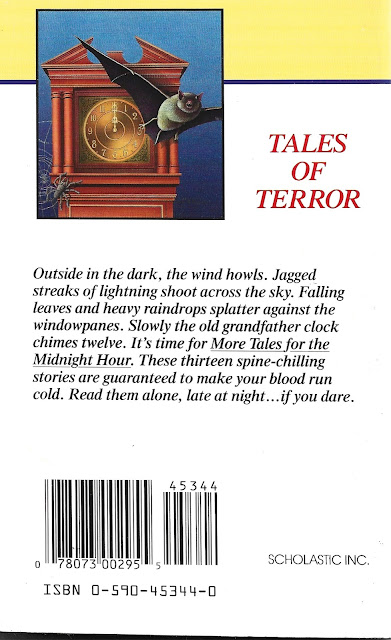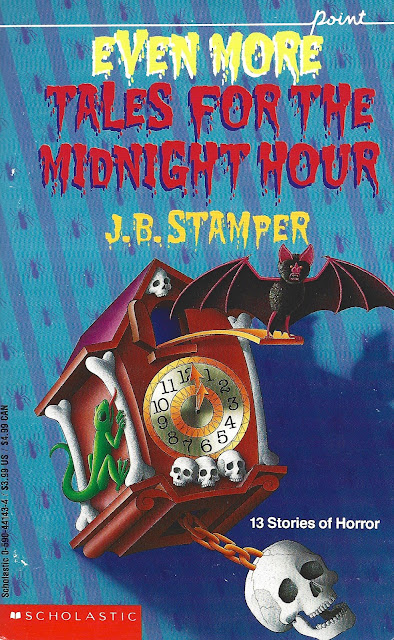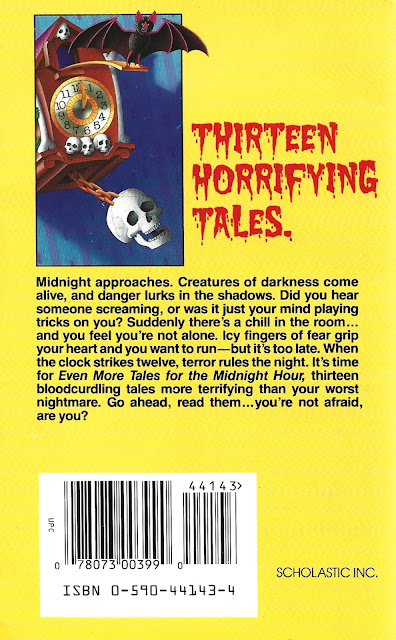THE COVER
With this, the first in the series from Baronet Books, Fright Time sets the stage for all the other gloriously dusty-looking art spreads to come. We have the first of many kids-in-sweaters slinking about in Hardy Boys fashion, his curious snooping in contest with the rugose horror that is forever lurking behind him in mid-pounce. Said horror here being the title character of the first story, "Madman on Main Street".
The uncredited artist's rendition of the villain gives him the whiff of the Crypt-Keeper, a feeling enhanced by the comic book-styled inclusion of the "issue" number and table of contents, but as we'll soon see in the story he comes across more like a kooky old pappy. That look wouldn't have suited the high drama of this cover, though. The clawed gentleman looks to be another piece of the decrepit atmosphere, a menacing addition to the shattered glass and antique furniture. But what is his ultimate purpose, and how does little Johnny fit into his schemes? Read on to find out!
THE REVIEW
"Madman on Main Street" by Elaine A. Kule
First of all, his name isn't Johnny. It's Michael Dane, age 12. Michael has the innocuous life that is the dream (and often the reality) of homogenized tweens throughout all of spooky kid bookdom: he lives in the suburbs (in the town of Centerville, natch), he has a newspaper route, and he's coasting by in school with iffy grades but loads of charm. It's on this last count that the SUPERNATURAL enters his life in the form of Abner Hilks, the aforementioned pappy who may-or-may-not live in Centerville's resident creepy old house. Abner's terrible when it comes to making conversation, but he's a pro at giving Michael the willies with his cackling portents of mysterious events soon to come.
The mysterious events soon to come turn out to be the sudden excelling of Michael's grades and his ascendance to star student at Centerville Junior High. Neglected homework assignments are turned in complete and unprepared test answers transform into big scores. Could this be the work of the ever reappearing-and-disappearing Abner Hilks? Yes.
With the help of plucky neighbor Cara, Michael discovers that Abner is a wizard--or as the kids call him, a "madman"--who is angling to get Michael in his back pocket so that he can get access through the newspaper offices to vital information that will help him blackmail prominent folks in town and, ultimately, assume total control of Centerville.
While the premise smells like vanilla from the word "go", author Elaine A. Kule does a solid job of keeping us engaged mostly by dint of Michael's voice. Michael, in a word, is well-rounded: he's not exactly a wiseacre, but he's no precocious brain either. He can be resourceful and funny and even kind, but frequently he is self-admittedly out of his depth when it comes to tackling this kind of problem. When he and Cara go to the police station to report Abner being a weirdo, Michael's discomfort and uncertainty ring true. What are they supposed to do? How do you handle what is essentially an adult harasser, let alone one who practices black magic and remains impervious to whonks on the head from a flashlight?
Some folks might count the fact that our tween heroes just stumble upon the means of disposing Abner (and that it is itself a nod to pop culture) against the story, but just like Michael's encounter with the cops this bit of good luck seems just as believable of a climax as any. (Thank God for the presence of orange soda!) You would think that this "error" would have been compounded when Kule interjected a moment of reflection for Michael at the story's conclusion of the "well, I learned something today" variety, but not so! At least not for this guy. I thought it was rather smart and sweet.
It's funny, because taking time to reflect on the story itself, there isn't very much that happens within its sixty pages. Structurally, it comes across very much like one of those literacy-boosting weekly readers on laminated cardstock that you would have gotten in grade school, something that skates by on charm without breaking any new ground or edging too close to the darker shades of horror. When you take into account that Kule is (or was) a reading specialist at an elementary school, according to this mini-bio from Enslow Publishing, then that vibe starts to make a lot of sense.
So kudos to you, Michael and Elaine! You got Fright Time started on a steady foot.
"It's Almost Dark" by Jane Ehlers
And then there's this one.
I'm not sure who Jane Ehlers was, or what she thought of children, or what she thought that children thought. All I know is that "It's Almost Dark" is ostensibly the story of a sleepover gone awry, and fittingly enough it reads like the long, spiraling soliloquy of a kid who has eaten too much sugar and gotten too little sleep but has finally plucked up enough courage to finally tell his ghost story even though that activity ended three hours ago and everyone else has gone to bed.
Ben is our narrator, and it is his stay in the house of the spooky-dooky Kadison family that serves as the catalyst for the action. Spencer Kadison may be slightly eccentric--his glasses are always sliding down his nose, you see, so you now know everything important about him--but it's Spence's parents that are the real deal. Mrs. K. is a Morticia Addams-type forever lighting candles and performing psychic readings for her clients, while Mr. K. is a children's writer and illustrator whose work tends towards the fearsome. His latest project is a book about some nasty goblin buggers whose disgusting features must be mentioned at every opportune moment. For instance:
He'd been drawing these gnome-like, wrinkled little squinty guys with pointed ears and dried leaves and damp-looking moss that clung to their bodies like messy little caveman suits. These creepy creatures gave off steam when they moved. They had matted, awful-looking hair, and scowly faces, too.
And have we talked about the body odor yet? Don't worry! Ehlers makes sure that you never forget about it.
Thing is, these creatures are hard enough to hear about as Mr. K. drones on in mock fear or look at sneering from his computer screen, but when the artist's new state-of-the-art image scanner gets thrown in the mix, you know sooner rather than later that we'll be seeing these little bastards tumbling through the house playing their goblin games. And sure enough, that is exactly what happens. There is some bizarre business about the goblins kidnapping Spence's little sister and the boys inadvertently kidnapping a goblin baby, but it all feels completely incidental and acts as a shaky means for the boys to get outside the house and stop fumbling around with their hockey sticks.
That breathless-kid-at-the-sleepover tone comes hard and fast once the goblins make their noxious entrance. The setup is clunky and awkward, and the remainder of the story is clunky and awkward, too, but it's also *fast*. It's hard to tell if Ehlers was trying to make up for a lackluster word count or attempting to mimic the hyped-up energy she observed in kids verbalizing their own stories, but either way the results end up looking like this:
Mr. K.'s picture! It was a face... that goblin! It was that goblin Mr. K had drawn that day I got spooked, and it was talking! That goblin-face was talking to us! "It's almost dark," it muttered in a low, growly voice, sneering at us. Slobbering, too. It was so gross.
There is a LOT of that kind of thing in "It's Almost Dark", Ben reminding us how revolting the goblins are and how "whacked out with fear" he is. And if you weren't convinced that Ben was really terrified, consider this powerful metaphor when he says he felt "as if I'd gulped down a golf ball of horror..."
The whole thing comes to a blazing end when Ben and Spence decide the only way to defeat the goblins is to bring another of Mr. K.'s crazy creations to life with the scanner: Tarx. Or, "Technically Advanced Robotic Exo-titans". Just what Tarx is I'll leave to the quotes section, but suffice to say the Robocop-ripoff and his brothers rain literal flaming death upon the goblins in a moment that must be read to be believed. So here, believe it:
The goblins were melting and shrieking! Their eyes were--and this freaked me out--dissolving and pouring out of their faces! They were coming at us, holding their dripping, steaming arms out in front of them, like the worst monster movie that ever kept you awake after you saw it! The smell was unbelievable, and their big, [sic] rats' teeth--suddenly they were dropping onto the ground!
Thus ends the saga of Ben, Spence, and the Funky Bunch. And that, too, of Jane Ehlers. That is, until we see her again in Fright Time #12. *cue shrieking violins*
"Scary Harry" by Terry Patrick
And then there's this one!
Sliding into home plate is this crackerjack, bonkers little yarn about two best bros and the adolescent changes that beset them. This being Horrorland, we know that the sudden distancing and physical transformation that Jesse notes in his older brother, Harry, aren't just the workings of puberty. There is an unquiet current of mystery rippling in the background--there are allusions to a crazy Uncle Barnaby who sends the boys strange trinkets from his globe-trotting exploits, whispers from neighbor Izzy (like Cara, another helpful female companion) concerning the previous owner of Jesse's house, a mad scientist who liked to play doctor (Moreau) with the neighborhood critters, and a general apprehension of monkeys that manifests itself in a surreal dream sequence and an upsetting aside regarding a visit to the zoo.
For some reason I recall thinking this one was pretty goofy on my initial read back in the day, but coming back to it as an adult I'm struck by how effectively creepy Harry's change is. This time out I was also more susceptible to not only Jesse's fear of his hairy-knuckled brother, but his concern for him. Jesse is not merely here to solve the story's mystery. He is a brother first and a detective second, and Patrick never lets us forget it.
A less daring writer might have taken the easy route and played up Harry's monkeyfication for laffs, but Patrick takes a decidedly serious approach to the concept. The sight of Harry walking around his room on his knuckles might seem patently absurd, but it comes across as unsettling. We feel for Jesse because he's watching incomprehensibly as his brother changes into something decidedly inhuman. And the danger of the situation is never sold short. You can feel the violence coiling in the brothers' tense interactions, and the "oh, snap" moment comes when Harry leaves a warning for his little brother in the form of a squirrel with a twisted neck. Curious George killed the rat!
That this impressive emotional throughline is spiked with well-crafted suspense scenes is all the more impressive. The uncovering of a secret basement while Harry stalks through the house looking for Jesse is worthy of Hitchcock, and the climactic scene of the two brothers in the same basement armed with baseball bat and samurai sword feels almost too good to be true given the measured expectations one brings to a series like Fright Time. It's a nice way to bring this first volume to a close and a delightful reminder of both the pathos and the weirdness that can be found in these literary curiosities.
THE QUOTES
She's this 11-year-old and a bit of a know-it-all. I'm sure you know the type; they're everywhere. Very annoying.
("Madman on Main Street")
Mom's voice rang out. "Michael, Cara's here to see you."
I heard a groan. It came from me.
("Madman on Main Street")
He led us down a narrow flight of stairs. I took Cara's hand. It was the least I could do. Poor kid. What a way to go.
("Madman on Main Street")
"What are you going to do with us?" I asked him. As a rule, I'm not big on surprises. Whenever possible, it's good to know what a crazy wizard has in store for you.
("Madman on Main Street")
It was Abner, howling and writhing in pain! "Help me," he managed to utter. "My skin is on fi-i-re."
("Madman on Main Street")
Maybe his intentions were honorable, and he just went after his goal, something he wanted very badly, the wrong way. Humans do, too, when you stop to think about it.
("Madman on Main Street")
The head warrior was an awesome combination of a Viking, a knight in armor, and a cop who time-travels by computer through cyberspace--you know--the information superhighway. He has everything--monster headgear with a night-vision visor, geographical-scanning grid, a sword made of some metal we haven't discovered yet, a laser device to deter bad guys. He can even launch fireballs from some kind of thing built into his forearm. He wears part armor, part animal skin. I didn't realize it then, but his name would stick with me for quite a while--Tarx.
("It's Almost Dark")
 |
| And this little thing in the stock that tells time. |
Mr. K came in. "Listen, guys," he said. "Ben, how about a sleepover this weekend? Spence, your mom and I would like to go to a movie or whatever while you guys watch Shannon for a few hours Saturday night. What do you say?"
("It's Almost Dark")
I groped through the hall, trying to find Spencer's room, feeling along the wall. I felt slimy stuff.
("It's Almost Dark")
Spencer opened the door. "Ben," he said, looking at me gravely, "my glasses are out there. Now I'll have to wear the nerdy ones."
("It's Almost Dark")
Yes, I was definitely smelling goblin again!
("It's Almost Dark")
I swallowed my usual ball of fear.
("It's Almost Dark")
"This can't be happening!" I moaned out loud.
("It's Almost Dark")
I was flooded with relief. Saved! Someone was coming through the opening. Yes! This nightmare is officially over! No! Not yet!
("It's Almost Dark")
He held on to me with a grip that was stronger than any dad's I know of.
("It's Almost Dark")
"First, breakfast," said Mom.
"Right," I said.
About five seconds later, I was out the door.
("Scary Harry")
Suddenly, all the birds started cackling at once and flapping their wings. Then the biggest of the flock bent over, coughing. I thought for a minute that he was going to throw up. But he heaved and heaved and coughed up a fur ball the size of my fist.
No. It wasn't a fur ball at all. It was a head. A shrunken head. I reached over to pick it up and it rolled away, opening its little mouth and laughing so loud the cackling birds fell silent.
("Scary Harry")
I was in the kitchen drinking some gorilla milk--that's what we call chocolate milk--when Harry walked in, carrying a grocery sack. . . . In the bag were about 10 pounds of bananas. I didn't think anything of it then.
("Scary Harry")
I walked into the kitchen. She was wearing pink sweatpants and a tee shirt. She had her hair pulled back into three ponytails. I liked Izzy. I felt like we were friends already.
("Scary Harry")
I stared at the gorilla for a long time. But just as I was about to leave, he suddenly turned toward me and looked right into my eyes.
Then he ripped the doll's head off and threw it at me. Two days later, I read in the paper that that ape had killed one of the other apes.
("Scary Harry")
As we had done a hundred times before, we each pricked our fingers with a pin, squeezed some blood out, and rubbed our fingers together. I can't tell you why we did it all those times in the past because I still have to keep those secrets.
("Scary Harry")
